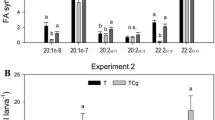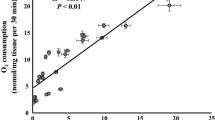Abstract
To study the intestinal fatty acid absorption in fish in vitro, enterocytes were isolated from the intestine of rainbow trout and incubated with an equimolar mixture of seven fatty acids [16:0, 18:1n-9, 18:2n-6, 18:3n-3, 20:4n-6, 20:5n-3 and 22:6n-3] in which the component carrying a radioactive label was varied. The fatty acid mixture was presented in the form of micelles formed by sonication with sodium taurocholate. Control studies showed that the presence of sodium taurocholate in the incubation medium caused an immediate 23% increase in the mortality of the cells but the remaining cells were viable. The effect of the bile salt on cellular permeability was evident at longer exposure periods. The proportions of 14C-labelled 20:5n-3 and 22:6n-3 present as monomeric fatty acids in the micellar solutions were higher than those of 16:0, 18:1n-9, 18:2n-6, 18:3n-3 and 20:4n-6. The rates of uptake of 14C-labelled 20:4n-6, 20:5n-3 and 22:6n-3 by enterocytes were significantly lower than those of the other fatty acid substrates over the first minute of incubation but no significant differences in uptake rate between fatty acids were obvious over a 15 min incubation period. Notable differences were observed between substrates in their distribution pattern in enterocyte lipid classes. Although most of the radioactivity from all radiolabelled substrates was recovered in triacylglycerols, the amounts of 14C- labelled 16:0, 20:4n-6, 20:5n-3 and 22:6n-3 recovered in the polar lipid fraction were higher than those of 14C-labelled C18 substrates, particularly after 15 min. Conversely, the initial esterification rates of 18:1n-9, 18:2n-6 and 18:3n-3 into triacylglycerols were significantly higher than those of 20:4n-6, 20:5n-3 and 22:6n-3. It is concluded that isolated enterocytes can be used for the study of the mechanism of intestinal fatty acid absorption in fish.
Similar content being viewed by others
References
Arnold-Reed, D.E., Bentley, P.J., Phan, C.T. and Redgrave, T.G. 1997. The clearance of lipids from the plasma of a teleost fish, the black bream (Acanthopagrus butcheri). Comp. Biochem. Physiol. 116A: 167-172.
Bell, M.V., Simpson, C.M.F. and Sargent, J.R. 1983. (n-3) and (n-6) polyunsaturated fatty acids in the phosphoglycerides of saltsecreting epithelia from two marine fish species. Lipids 18: 720-726.
Bell, M.V., Henderson, R.J., Pirie, J.S. and Sargent, J.R. 1985a. Effect of dietary polyunsaturated fatty acid deficiencies on mortality, growth and gill structure, in the turbot Scophthalmus maximus. J. Fish Biol. 26: 181-191.
Bell, M.V., Henderson, R.J. and Sargent, J.R. 1985b. Changes in the fatty acid composition of phospholipids from turbot (Scophthalmus maximus) in relation to dietary polyunsaturated fatty acid deficiencies. Comp. Biochem. Physiol. 81B: 193-198.
Castell, J.D., Sinnhuber, R.O., Wales, J.H. and Lee, J.D. 1972. Essential fatty acids in the diet of rainbow trout (Salmo gairdneri): growth, feed conversion and some gross deficiency symptoms. J. Nutr. 102: 77-86.
Chow, S.L. and Hollander, D. 1978. Arachidonic acid intestinal absorption: mechanism of transport and influence of luminal factors on absorption in vitro. Lipids 13: 768-776.
Christie, W.W. 1982. Lipid Analysis, 2nd Edn. Pergamon Press, Oxford.
Coleman, R., Iqbal, S., Godfrey, P.P. and Billington, D. 1979. Composition of several mammalian biles and their membranedamaging properties. Biochem. J. 178: 201-208.
Fasano, A., Budillon, G., Guandalini, S., Cuomo, R., Parrilli, G., Cangiotti, A.M., Morroni, M. and Rubino, A. 1990. Bile acids reversible effects on small intestinal permeability. Dig. Dis. Sci. 35: 801-808.
Folch, J., Lees, M. and Sloane Stanley, G.H. 1957. A simple method for the isolation and purification of total lipids from animal tissues. J. Biol. Chem. 226: 497-509.
Freel, R.W., Hatch, M., Earnest, D.L. and Goldner, A.M. 1983. Role of tight-junctional pathways in bile salt-induced increases in colonic permeability. Am. J. Physiol. 245: G816-G823.
Ghosh, D., Williams, M.A. and Tinoco, J. 1973. The influence of lecithin structure on their monolayer behaviour and interactions with cholesterol. Biochim. Biophys. Acta 291: 351-362.
Goré, J. and Hoinard, C. 1993. Linolenic acid transport in hamster intestinal cells is carrier-mediated. J. Nutr. 123: 66-73.
Goré, J., Hoinard, C. and Couet, C. 1994. Linoleic acid uptake by isolated enterocytes: influence of α-linolenic acid on absorption. Lipids 29: 701-706.
Hegazy, E., López del Pino, V. and Schwenk, M. 1983. Isolated intestinal mucosa cells of high viability from guinea pig. Eur. J. Cell Biol. 30: 132-136.
Koven, W.M., Henderson, R.J. and Sargent, J.R. 1997. Lipid digestion in turbot (Scophthalmus maximus): in-vivo and invitro studies of the lipolytic activity in various segments of the digestive tract. Aquaculture 151: 155-171.
Leger, C. 1985. Digestion, absorption and transport of lipids. In: Nutrition and Feeding in Fish. pp. 299-331. Edited by C.B. Cowey, A.M. Mackie and J.G. Bell. Academic Press, London.
Lie, Ø. and Lambersten, G. 1991. Lipid digestion and absorption in cod (Gadus morhua), comparing triacylglycerols, wax esters and diacylalkylglycerols. Comp. Biochem. Physiol. 98A: 159-163.
Lie, Ø., Lied, E. and Lambersten, G. 1987. Lipid digestion in cod (Gadus morhua). Comp. Biochem. Physiol. 88B: 697-700.
Lie, Ø., Sandvin, A. and Waagbø, R. 1993. Influence of dietary fatty acids on the lipid composition of lipoproteins in farmed Atlantic salmon (Salmo salar). Fish Physiol. Biochem. 12: 249-260.
Ling, K.Y., Lee, H.Y. and Hollander, D. 1989. Mechanisms of linoleic acid uptake by rabbit small intestinal brush border membrane vesicles. Lipids 24: 51-55.
Lowry, O.H., Rosebrough, N.J., Farr, A.L. and Randall, R.J. 1951. Protein measurement with folin phenol reagent. J. Biol. Chem. 193: 265-275.
Mourente, G. and Tocher, D.R. 1993. The effects of weaning on to a dry pellet diet on brain lipid and fatty acid compositions in post-larval gilthead sea bream (Sparus aurata L.). Comp. Biochem. Physiol. 104A: 605-611.
Mourente, G., Rodríguez, A., Tocher, D.R. and Sargent, J.R. 1993. Effects of dietary docosahexaenoic acid (DHA; 22:6n-3) on lipid and fatty acid compositions and growth in gilthead sea bream (Sparus aurata L.) larvae during first feeding. Aquaculture 112: 79-98.
Ockner, R.K. and Manning, J.A. 1974. Fatty acid binding protein in small intestine. Identification, isolation and evidence for its role in cellular fatty acid transport. J. Clin. Invest. 54: 326-338.
Olsen, R.E. and Henderson, R.J. 1989. The rapid analysis of neutral and polar marine lipids using double-development HPTLC and scanning densitometry. J. Exp. Mar. Biol. Ecol. 129: 189-197.
Olsen, R.E., Henderson, R.J. and Ringo, E. 1998. The digestion and selective absorption of dietary fatty acids in Arctic charr, Salvelinus alpinus. Aquacult. Nutr. 4: 13-22.
Proulx, P., Aubry, H., Brglez, I. and Williamson, D.G. 1984. Studies on the mechanism of cholesterol uptake and on the effects of bile salts on this uptake by brush border membranes isolated from rabbit small intestine. Biochim. Biophys. Acta 778: 586-593.
Proulx, P., Aubry, H., Brglez, I. and Williamson, D.G. 1985. Studies on the uptake of fatty acids by brush border membranes of the rabbit intestine. Can. J. Biochem. Cell. Biol. 63: 249-256.
Ranheim, T., Gedde-Dahl, A., Rustan, A.C. and Drevon, C.A. 1994. Fatty acid uptake and metabolism in CaCo-2 cells: eicosapentaenoic acid (20:5(n-3)) and oleic acid (18:1(n-9)) presented in association with micelles or albumin. Biochim. Biophys. Acta 1212: 295-304.
Rodríguez, C., Pérez, J.A., Lorenzo, A., Izquierdo, M.S. and Cejas, J.R. 1994. n-3 HUFA requirement of larval gilthead seabream Sparus aurata when using high levels of eicosapentaenoic acid. Comp. Biochem. Physiol. 107A: 693-698.
Sargent, J.R., Bell, M.V., Bell, J.G., Henderson, R.J. and Tocher, D.R. 1995. Origins and functions of n-3 polyunsaturated fatty acids in marine organisms. In: Phospholipids: Characterization, Metabolism and Novel Biological Applications. pp. 248-258. Edited by G. Cevc and F. Paltauf. American Oil Chemist Society Press, Champaign, III, USA.
Sheridan, M.A., Friedlander, J.K.L. and Allen, W.V. 1985. Chylomicra in the serum of postprandial steelhead trout (Salmo gairdneri). Comp. Biochem. Physiol. 81B: 281-284.
Shiau, Y.F. 1990. Mechanism of intestinal fatty acid uptake in the rat: the role of an acidic microclimate. J. Physiol. 421: 463-474.
Sire, M.F., Lutten, C. and Vernier, J.M. 1981. New views on intestinal absorption of lipids in teleostian fishes: an ultrastructural and biochemical study in rainbow trout. J. Lipid Res. 22: 81-94.
Stremmel, W. 1988. Uptake of fatty acids by jejunal mucosal cells is mediated by a fatty acid binding membrane protein. J. Clin. Invest. 82: 2001-2010.
Stremmel, W. and Hofmann, A.F. 1990. Intestinal absorption of unconjugated dihydroxy bile acids: non-mediation by the carrier system involved in long chain fatty acid absorption. Lipids 25: 11-16.
Thomson, A.B.R., Keelan, M., Garg, M.L. and Clandinin, M.T. 1989. Intestinal aspects of lipid absorption. Can. J. Physiol. Pharmacol. 67: 179-191.
Trotter, P.J. and Storch, J. 1991. Fatty acid uptake and metabolism in a human intestinal cell line (CaCo-2): comparison of apical and basolateral incubation. J. Lipid Res. 32: 293-304.
Vernier, J.M. and Sire, M.F. 1983. L'absorption intestinale des lipides chez la truite arc-en-ciel (Salmo gairdnerii). Bases biologiques de l'aquaculture. 1983 IFREMER Actes de Colloques 1: 393-428.
Wallaert, C. and Babin, P.J. 1994. Effects of temperature variations on dietary lipid absorption and plasma lipoprotein concentrations in trout (Oncorhynchus mykiss). Comp. Biochem. Physiol. 109B: 473-487.
Watanabe, T., Ogino, C., Koshiishi, Y. and Matsunaga, T. 1974. Requirement of rainbow trout for essential fatty acids. Bull. Jap. Soc. Sci. Fish. 40: 493-497.
Westergaard, H. and Dietschy, J.M.1976. The mechanism whereby bile acid micelles increase the rate of fatty acid and cholesterol uptake into the intestinal mucosal cell. J. Clin. Invest. 58: 97-108.
Wilson, F.A., Salle, V.L. and Dietschy, J.M. 1971. Unstirred water layers in intestine: rate determinant for fatty acid absorption from micellar solutions. Science 174: 1031-1033.
Yone, Y. and Fujii, M. 1975. Studies on nutrition of red sea bream. XI. Effect of ω3 fatty acid supplement in a corn oil diet on growth rate and feed efficiency. Bull. Jap. Soc. Sci. Fish. 41: 73-77.
Zar, J.H. 1984. Biostatistical Analysis, 3rd Edn. Prentice Hall, Englewood Cliffs.
Author information
Authors and Affiliations
Rights and permissions
About this article
Cite this article
Pérez, J., Rodríguez, C. & Henderson, R. The uptake and esterification of radiolabelled fatty acids by enterocytes isolated from rainbow trout (Oncorhynchus mykiss). Fish Physiology and Biochemistry 20, 125–134 (1999). https://doi.org/10.1023/A:1007795516689
Issue Date:
DOI: https://doi.org/10.1023/A:1007795516689




